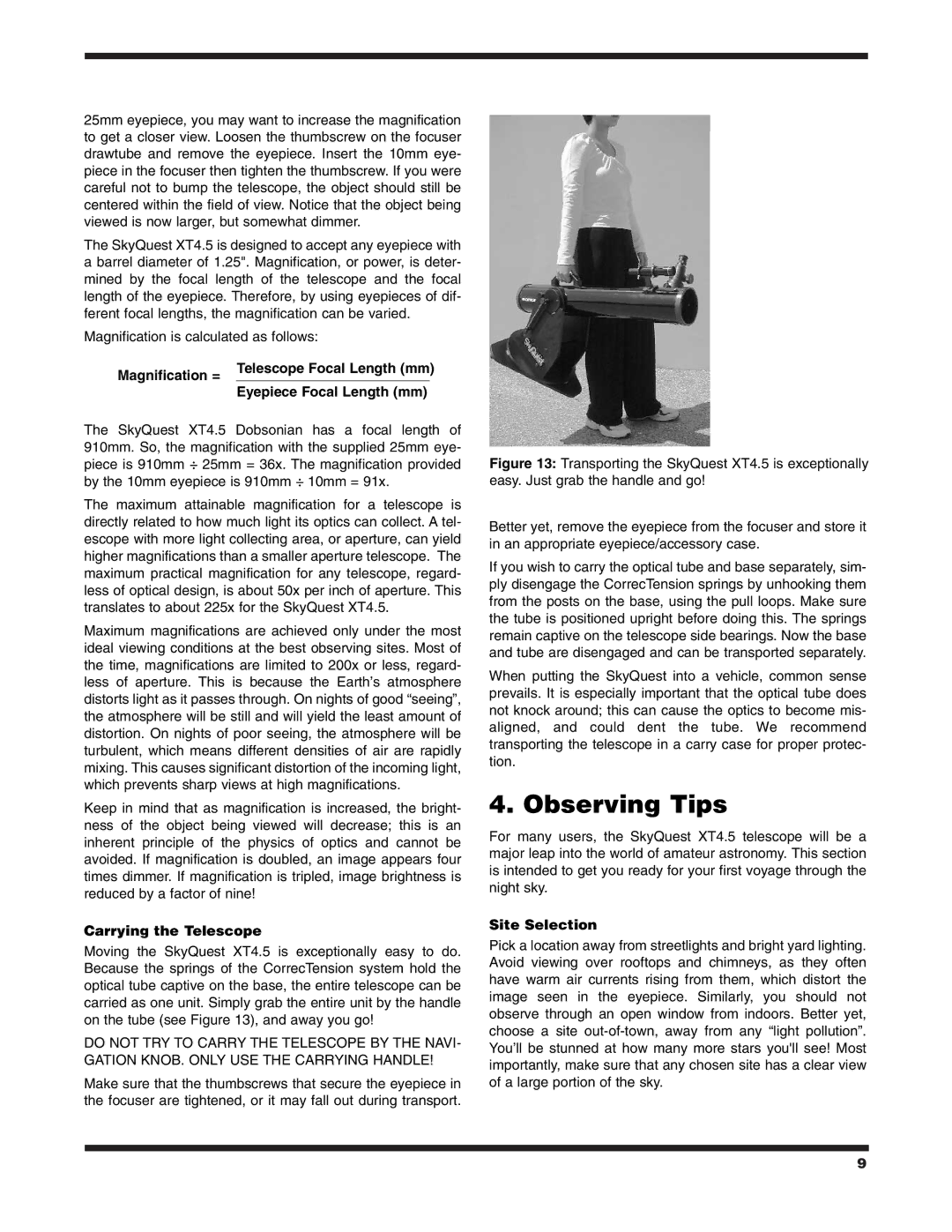
25mm eyepiece, you may want to increase the magnification to get a closer view. Loosen the thumbscrew on the focuser drawtube and remove the eyepiece. Insert the 10mm eye- piece in the focuser then tighten the thumbscrew. If you were careful not to bump the telescope, the object should still be centered within the field of view. Notice that the object being viewed is now larger, but somewhat dimmer.
The SkyQuest XT4.5 is designed to accept any eyepiece with a barrel diameter of 1.25". Magnification, or power, is deter- mined by the focal length of the telescope and the focal length of the eyepiece. Therefore, by using eyepieces of dif- ferent focal lengths, the magnification can be varied.
Magnification is calculated as follows:
Magnification = | Telescope Focal Length (mm) | |
| Eyepiece Focal Length (mm) |
|
The SkyQuest XT4.5 Dobsonian has a focal length of 910mm. So, the magnification with the supplied 25mm eye- piece is 910mm ÷ 25mm = 36x. The magnification provided by the 10mm eyepiece is 910mm ÷ 10mm = 91x.
The maximum attainable magnification for a telescope is directly related to how much light its optics can collect. A tel- escope with more light collecting area, or aperture, can yield higher magnifications than a smaller aperture telescope. The maximum practical magnification for any telescope, regard- less of optical design, is about 50x per inch of aperture. This translates to about 225x for the SkyQuest XT4.5.
Maximum magnifications are achieved only under the most ideal viewing conditions at the best observing sites. Most of the time, magnifications are limited to 200x or less, regard- less of aperture. This is because the Earth’s atmosphere distorts light as it passes through. On nights of good “seeing”, the atmosphere will be still and will yield the least amount of distortion. On nights of poor seeing, the atmosphere will be turbulent, which means different densities of air are rapidly mixing. This causes significant distortion of the incoming light, which prevents sharp views at high magnifications.
Keep in mind that as magnification is increased, the bright- ness of the object being viewed will decrease; this is an inherent principle of the physics of optics and cannot be avoided. If magnification is doubled, an image appears four times dimmer. If magnification is tripled, image brightness is reduced by a factor of nine!
Carrying the Telescope
Moving the SkyQuest XT4.5 is exceptionally easy to do. Because the springs of the CorrecTension system hold the optical tube captive on the base, the entire telescope can be carried as one unit. Simply grab the entire unit by the handle on the tube (see Figure 13), and away you go!
DO NOT TRY TO CARRY THE TELESCOPE BY THE NAVI- GATION KNOB. ONLY USE THE CARRYING HANDLE!
Make sure that the thumbscrews that secure the eyepiece in the focuser are tightened, or it may fall out during transport.
Figure 13: Transporting the SkyQuest XT4.5 is exceptionally easy. Just grab the handle and go!
Better yet, remove the eyepiece from the focuser and store it in an appropriate eyepiece/accessory case.
If you wish to carry the optical tube and base separately, sim- ply disengage the CorrecTension springs by unhooking them from the posts on the base, using the pull loops. Make sure the tube is positioned upright before doing this. The springs remain captive on the telescope side bearings. Now the base and tube are disengaged and can be transported separately.
When putting the SkyQuest into a vehicle, common sense prevails. It is especially important that the optical tube does not knock around; this can cause the optics to become mis- aligned, and could dent the tube. We recommend transporting the telescope in a carry case for proper protec- tion.
4. Observing Tips
For many users, the SkyQuest XT4.5 telescope will be a major leap into the world of amateur astronomy. This section is intended to get you ready for your first voyage through the night sky.
Site Selection
Pick a location away from streetlights and bright yard lighting. Avoid viewing over rooftops and chimneys, as they often have warm air currents rising from them, which distort the image seen in the eyepiece. Similarly, you should not observe through an open window from indoors. Better yet, choose a site
9
